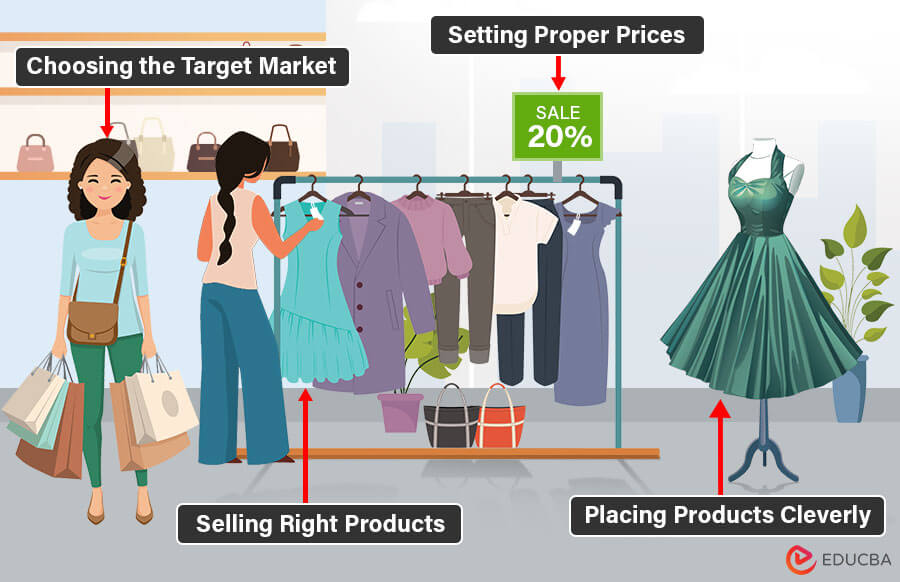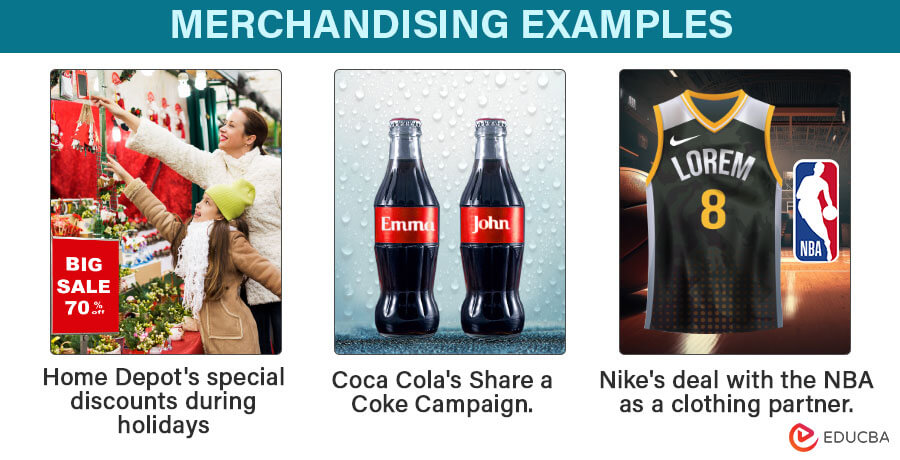What is Merchandising?
Merchandising is when businesses cleverly showcase their product and services in retail stores, online platforms, or marketplaces to make them more appealing and boost sales.
This strategy involves making the product visually appealing, offering discounts and sale promotions, selecting the right product, and setting the correct prices. The primary objective of merchandising is to capture the attention of potential customers towards the products, generate interest in the offerings, and make the purchasing process as convenient as possible.
Table of Contents
- What is Merchandising?
- How Does it Work?
- Examples
- Types
- Strategies
- Challenges
- Merchandising Companies vs. Service Companies
Key Highlights
- Merchandising is a marketing and sales strategy retailers use to boost product sales and influence consumer buying behavior.
- This approach involves creatively presenting and selling products in physical stores or online to attract customers and encourage purchases.
- Promotional strategies include packaging design, free samples, discounts, coupons, and setting correct pricing. Platforms like Bountii play a crucial role in these strategies by offering discounted coupons. These coupons help consumers save money on their purchases while also driving traffic and sales for businesses.
How Does Merchandising Work?
Let’s understand how merchandise works with the help of an example.
Step #1: Product Selection: Retailers choose which products to sell based on customer demand, trends, and profitability.
Example: Consider you own an ice cream parlor and want to attract local customers. You can select flavors that customers in your area prefer.
Step #2: Pricing: Retailers decide how much to charge for products, considering costs, competition, and what customers are willing to pay.
Example: You can determine ice cream prices depending on the ingredients’ quality, production costs, and the local market.
Step #3: Product Placement: Products are strategically placed in stores or online to catch the customer’s eye. It includes deciding where and how to display items for maximum visibility.
Example: You can keep posters displaying ice cream flavors at the entrance or cash counter.
Step #4: Visual Appeal: Retailers create attractive displays and packaging to make products appealing and enticing to customers.
Example: You can also showcase wedding rings in elegant cases and package them in beautiful boxes to make them stand out.
Step #5: Promotions: Retailers use special offers, discounts, and marketing campaigns to attract customers and boost sales.
Example: To attract more customers and boost sales, you can offer special discounts, like “Buy 2 Get 1 free“. Or “Buy 2 for $5.”
Examples
Now, let’s explore some real-time examples of merchandising.
Example #1
Home Depot, an American home improvement retail store, uses marketing strategies such as offering substantial discounts during major holidays like Christmas, Thanksgiving, and Black Friday. It helps them attract many customers, leading to increased product sales. This merchandising strategy has successfully driven consumer interest and boosted revenue during these holiday shopping seasons.
Example #2
Coca-Cola’s “Share a Coke” encouraged consumers to share a Coke with friends or family, making Coca-Cola not just a drink but also a way to connect socially with people. This emotional connection is a great example of effective merchandising, building brand loyalty, and increasing sales. Moreover, the campaign’s other marketing approaches, like TV, outdoor advertising, radio, and cinema, also effectively reached a wide and diverse audience, attracting customers to their products.
Example #3
Nike, the American sportswear brand, signed a contract with the National Basketball Association (NBA) in June 2015. This deal lasted eight years, starting from the 2017-18 season. Nike was the first official clothing partner of the NBA, with its logo appearing on team uniforms. This merchandising move was part of Nike’s business strategy to increase sportswear sales among various groups of people.
4. Visual selling
This type of merchandising involves the display of products in stores or websites. It includes designing store layouts, product displays, price tag signs, and packaging to create an attractive and friendly shopping environment.
5. Multi-channel sales
Multi-channel sales means businesses use different ways to sell products, like online, in a store, or over the phone. They want to ensure customers have a smooth shopping experience no matter how they buy. For instance, stores with social media accounts talk to their customers online, send them emails about sales, and approach them to special events.
6. Sensory Merchandising
Sensory merchandising aims to improve the shopping experience of customers. It includes using music, lighting, scents, and other elements to create a pleasant store ambiance.
Strategies
Here are some key merchandising strategies that encompass the various aspects mentioned:
- Store Design: It includes a retail store’s layout, aesthetics, and overall atmosphere. Retailers should strategically plan to enhance the shopping experience and influence customer behavior.
- Free Product Samples: Retailers offer small quantities of their products for customers to try before purchasing. This tactic allows customers to experience the product’s quality, potentially leading to future sales.
- Discounts and Coupons: Retailers provide products at low prices or offer coupons to make customers purchase that product. This strategy makes customers buy something quickly because it’s a good deal.
- Special Offers: It includes limited-time promotions, discounts, or exclusive deals, like “Buy 1 get 1 Free” to attract customers. These offers make shopping exciting and encourage customers to make immediate purchases.
- Competitive Pricing: It means setting prices for products similar to what other stores charge. This strategy aims to attract customers with good price deals and maintain competitiveness.
- Points of Sale (POS): Points of sale are locations where customers pay for their purchases. It aims to provide a hassle-free experience by ensuring that payment methods are smooth, there are no technical issues, and the process is user-friendly.
Challenges of Merchandising
Some of the common challenges merchandisers face are as follows:
- Estimating high demand can result in overstocking and increased inventory costs, while estimating too low can lead to product shortages.
- Inventory management involves managing stock levels, tracking sales, and optimizing supply chain logistics, which can be complex and costly.
- Seasonal changes can cause fluctuations in business demand, making retailers adjust their product offerings, displays, and marketing strategies accordingly.
- Determining the optimal prices and maintaining competitiveness and profitability is a constant challenge.
- Maintaining a competitive edge in the market requires constant adaptation to changing consumer preferences and trends, as failure to do so can lead to outdated or unpopular products.
Merchandising Companies Vs. Services Companies
Let’s explore the difference between merchandising companies and service companies.
| Aspects | Merchandising Companies | Services Companies |
| Nature of Business | Merchandising companies primarily sell physical or digital products to customers. | Services companies provide intangible services to clients or consumers, like consulting. |
| Inventory Management | They manage physical inventory. | There is no physical inventory. |
| Customer Interaction | Customers purchase products and have direct interactions with the company. | Customers receive services like consultation, support, and addressing specific needs. |
| Examples | Retail stores and e-commerce businesses. | Consulting firms, software service providers, marketing agencies, and professionals offering specialized services. |
| Inventory Risk | They face inventory risks, like overstocking or understocking products. | They do not have inventory, so the risk is minimal. |
Final Thoughts
Merchandising is vital for retailers as it directly impacts sales and customer loyalty. Whether the store operates physically or online, the store’s presentation is crucial. Factors like cleanliness, organization, accessibility, and strategic use of discounts and promotions can influence sales. Effective marketing can help businesses build their brand and stay competitive, even during tough economic times.
Frequently Asked Questions (FAQs)
Q1. What is the purpose of Merchandising?
Answer: The purpose of merchandising is to optimize product presentation and marketing strategies to attract customers, drive sales, and enhance the overall shopping experience.
Q2. What are the parts of Merchandising?
Answer: The merchandising framework has four essential parts (P’s) that help businesses manage their product strategy effectively. These four key elements are Product, Price, Placement, and Promotion.
Q3. What are the tools of Merchandising?
Answer: The following are some standard tools businesses use for merchandising.
- Planograms (design showing the exact placement of products in a store).
- Price Tags and Labels
- Promotional Displays
- Inventory Management Software
Recommended Articles
This article provides comprehensive information about merchandising, including its types, how it works, strategies, and challenges. We hope this article was helpful to you. You can also refer to our other articles,


